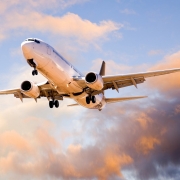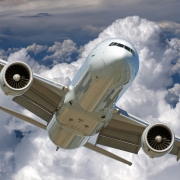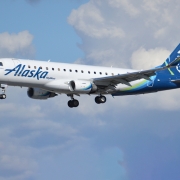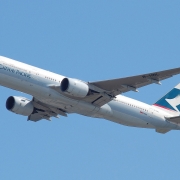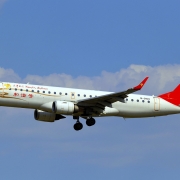The Changing Scope Clause Environments
One of the major undercurrents in the U.S. airline industry today is the changing relationship between the legacy airlines and the regional airlines that feed into their networks. The relationship between regional carriers and their larger US counterparts has been dependable for 20 years, but that is all poised to change as the status quo is facing challenges in airlines evolving business dynamics.
As noted in mba insights The Pilot Shortage: A Current and Future Threat (March 13, 2017), the industry is feeling the impact from diminishing available pilot numbers; this reality paired with record airline profits, and exploding demand in the travel industry have placed pilot union negotiators working on behalf of legacy airlines in a uniquely strong position. To add context, these same legacy airlines, now gaining leverage in negotiations, have often held the view that for 15 years low cost regional airlines were being given routes/operations that should be or belonged within the purview of legacy carriers. Now, major airline’s labor is poised to bring as much of that flying into the mainline operations by using more restrictive scope clause language. In turn, the shrinking regional airline marketplace will place more competitive pressure on smaller airlines already struggling to recruit pilots and maintain market share. This mba insight will cover these dynamics in a brief analysis below, exploring the history behind scope clauses, explaining current trends in the U.S. airline industry, and the likely effects that scope clause restrictions will have on regional airline aircraft deliveries going forward.
Scope Language – Crucial to any Pilot’s Contract
Most airline pilot groups in the U.S. are unionized and work under a collective bargaining agreement (CBA) or a pilot working agreement. These contracts are negotiated with the management of their respective air carriers and their language determines the scope of impact and the parties’ roles in any event or change that could possibly affect the careers of the pilots, as well as the property or operations of the airlines. Most importantly, the Scope Language; the scope of the contract defines what type of flying is covered by the CBA, determines what flying remains outside the coverage of the agreement, and under which circumstances the airlines may use “lift” from other carriers. Scope clauses can be viewed as protective in nature, ensuring the larger airline pilot jobs are maintained, but a major effect of the agreements to date have been the type of relief or allowance also granted under the scope language to the regional operators, terms that in essence supports the existence of regional airlines in the U.S.
A Brief History of Scope – A Concept Born of Necessity and Crisis
When we consider large airline companies in the United States, it is helpful to classify them by three categories: Legacy airlines, major airlines, and regional airlines. Legacy airlines—American Airlines, Delta Air Lines, and United Airlines—are large passenger carriers with corporate lineage well before deregulation. Legacy carriers are hub based and are fed by a network of subsidiary carriers known as regional airlines operating smaller aircraft. Major Airlines include the likes of Southwest Airlines, Spirit, and JetBlue. While they may operate large hub facilities, their distinction from Legacy carriers is that Majors do not utilize affiliate regionals to feed passengers into their operations.
The legacy airline/regional airline relationship dates back to 1967, when the Civil Aeronautics Board (predecessor to the FAA) allowed large airlines to transfer unprofitable routes under their control to subcontracted airlines with smaller aircraft. We now refer to this practice as codesharing, but at the time this arrangement between operators was new for the industry; large airlines begin using subcontractors flying smaller aircraft, but they were operated under the major airline’s brand for “thin routes” more economically. Pilots at the large airlines were willing to provide scope relief for these operations; particularly as the small aircraft pay rates were low enough that senior pilots had little interest in servicing those flights.
By 1972, the CAB had relaxed the regulations sufficiently to allow commuter airlines to operate aircraft with as many as 30 seats. Major and national airline pilot groups, experiencing the impact of the energy crisis and exploding inflation that characterized 1970s, were willing to grant further scope clause relief to allow their companies to stay afloat.
Airline deregulation in 1978 led to significant industry turbulence, eventually causing much of the industry to consolidate into the legacy airlines that we have today. This was an opportunity for small regional airlines; as not only were the old CAB seat caps a thing of the past, but the legacy airlines no longer received subsidies to operate unprofitable routes. Many of these routes were transferred to the regional airlines, giving rise to the now familiar hub-and-spoke system of operation. Regional airlines were effectively employed to increase the overall power of the hub; with the purpose of getting more passengers into the hub airports, thus driving up system revenue passenger miles. The regionals were paid by the legacy airlines in a fee-for-departure scheme that wasn’t dependent on load factor. Scope clauses were further relaxed to support this business model; 50 seat turboprop aircraft (and larger) were regularly employed in the service of regional airlines.
Throughout the 1990s and 2000s, the scope clause restrictions in the CBA’s of the legacy airlines were relaxed even further. The Gulf War, 9/11, and the War on Terrorism in Iraq and Afghanistan lent an air of cyclical instability to the airline industry. In order to drive down costs and feed the hubs, the legacy airlines entered into more code sharing agreements for even larger aircraft. The 1990s saw the advent of 50 seat regional jets which were flown in large numbers. By the early 2000s, 70 seat and larger regional jets (CRJ 700, CRJ 900, and ERJ-170/175) began to become commonplace. Faced with high oil prices, a brutal competitive environment, and the threat of furloughs, legacy airline pilot union negotiators faced little choice but to acquiesce to further scope clause relief.
What had begun as a method of maintaining a foothold in an unprofitable market by using small turboprops had grown into an outsourcing business model that saw aircraft with up to 90 seats flying routes of 1,400 nm and more. In 2005, the regional airlines outpaced their major airline partners, billion revenue passenger miles[i].
Current Scope Clause Restrictions
Today’s CBA scope clause restrictions are complicated; they commonly dictate the number of regional airline aircraft that can be engaged as a function of a ratio to mainline aircraft, limit hub to hub regional airline operations, impose statute mile limits on the routes that regional airline aircraft can fly, and restrict the number of block hours that can be flown by the regionals as a percentage of total system block hours. Legacy airlines are wary of exceeding these limitations, as the CBAs generally impose significant penalties on the carrier for allowing subsidiary flying beyond the contractual limit. Even more significantly for future deliveries of regional airline aircraft, the CBA scope clauses impose maximum gross takeoff weight (MGTOW) restrictions on new aircraft operated by their regional partners; American Airlines, United Airlines, and Delta Air Lines pilots all restrict aircraft operated by their regional affiliates to 86,000 lbs. MGTOW.
Summary of Major Airline Scope Clause Restrictions
| 37 Seat Turboprops | 50 Seat Aircraft | 70 Seat Aircraft | 76 Seat Aircraft | |
| Delta Air Lines | YES | Up to 348 aircraft1 | Up to 102 aircraft | Up to 153 aircraft2 |
| United Airlines3 | YES | Up to a number equal to 90% of the UAL single aisle fleet | Up to 255 70 and 76 seat aircraft | Up to 255 70 and 76 seat aircraft, not to exceed 153 76 seat aircraft |
| American Airlines4 | YES | YES | Above 65 seats, a number not to exceed 40% of the mainline narrowbody fleet | Above 65 seats, a number not to exceed 40% of the mainline narrowbody fleet5 |
- Reduced by 2.3 to 4.6 aircraft per 76 seat aircraft added to the regional fleet.
- May be increased to 233 with the introduction of a new small narrowbody aircraft to the Delta Air Lines Fleet.
- 80% of United Express flying must be under 800 nm.
- The total number of regional aircraft with greater than 30 seats cannot exceed 75% of the active mainline narrowbody fleet.
- The 76 CRJ-900 and ERJ-175 aircraft and their successors seating 79-80 passengers that were part of the U.S. Airways system are grandfathered in.
The Pilot Unions are in the Driver’s Seat
Today, we are seeing a confluence of several factors that promise to tilt the scope clause negotiating environment in the pilot unions’ favor. These disrupters not only make it unlikely that further scope relief will be granted, but we may even see a return of much of what has been regional flying to the mainline operators. Delta Air Lines has already replaced many of the routes formally flown by the now defunct regional airlines ASA and Comair with Boeing 717 and Airbus A319/A320 aircraft.
The disrupters which will affect the scope clause negotiating climate are:
- The pilot shortage: According to the latest Boeing Pilot and Technician outlook, the North American airline industry needs to find 112,000 more pilots to fill the ranks between now and 2035 due to growth bubble in pilot retirements[i]. With the rate of student pilot starts still well below the level that they were at even during the 2006-2007 recession[ii], there is little hope of stopping what promises to be a staffing shortage of crisis proportions. Indeed, Republic Airways cited pilot staffing levels to be a primary driver of their 2016 bankruptcy filing[iii]. Regional airlines have to offer increasingly lucrative financial incentives to attract pilots, eroding the economic advantage of the fee-for-departure model used by the legacy airlines.
- The airlines are making money: The global airline business has become a profitable enterprise, and North America is leading the way. The past three years have been the most profitable in history, and North American airlines are expected to net as much $18.1 billion in 2017[iv]. As we have seen from historical analysis, scope clause relief is normally a response to economic pressure. That pressure does not exist today.
- Industry growth promises to continue: IATA is forecasting that worldwide passenger demand will double in the next 20 years. While the developing powerhouses of India and China will account for much of this growth, the FAA anticipates that revenue passenger miles flown by U.S. carriers will increase by 2.6% per year until 2036. This growth with the mainline air carriers is predicted to be strongest on international routes[v]. When the legacy airlines are in a growth mode, there is little reason for pilot unions to grant scope relief.
- Rationalized route structures: One of the primary drivers of profitability at the legacy airlines has been extremely aggressive capacity control; airlines have shown little hesitancy to remove seats from the market to tighten supply. This has resulted in the reduction or elimination of service to many secondary and tertiary markets. Since these thin routes are the raison d’être for regional airlines, fewer secondary and tertiary markets means a reduced demand for the scope relief required to support fee-for-departure operations.
- Regional jets are turboprops and aging: Many 50 seat regional jets and 37-50 seat turboprops are reaching the end of their economic life cycle. For example, American Airlines is set to retire 55 aircraft from their regional fleet by the end of 2017 (mostly Dash 8s and CRJ 200s). While there are some ERJ 175s and CRJ 700s being added to the fleet, American is still planning on a net loss of 24 regional aircraft. This plan isn’t unique—the retirement of smaller and older regional aircraft is a common refrain across the industry. Fewer regional aircraft means less scope relief will be required.
It is worth noting that the value of thin routes and the importance of the hubs are not lost on the pilots’ unions. By all appearances, they seem to want to bring that flying back into the mainline fold; Delta Air Lines, American Airlines, and United Airlines pilots have all negotiated pay rates for the Embraer 190, CS100, and CS300 aircraft. Since pay rates for these aircraft exist in the current major airline CBAs, it is extremely unlikely that unions will grant further scope relief to allow these larger aircraft to be flown by their regional counterparts.
Scope Clause Trends and Future Aircraft Deliveries
The current economic environment, scarce pilot resources, and industry growth have created a collective bargaining environment that is very much in the pilots’ favor. As we have seen, scope relief has often been a product of industry turbulence; regulatory changes, conflicts, spiking energy prices and terrorist attacks all played a role in creating the scope environment that led to the growth of the regional airline industry. After a long period of consolidation that followed deregulation, a sustained period of profitability has been realized, there is little motivation for pilot groups to give ground in terms of scope relief. Additionally, the capacity discipline exercised by the legacy airlines has proven that profitability can be achieved without serving many secondary and tertiary markets. In short, the legacy airlines do not currently require scope relief to thrive.
If there are to be any changes in the scope restrictions on regional flying imposed by the CBAs at the legacy carriers, what those changes will look like will begin to become clear within the next few years. Delta Air Lines and United Airlines are both scheduled to open contract negotiations with their pilots in 2019, followed by American Airlines in 2020. Alaska Airlines, which operates a small fleet of regional jets and turboprops through its wholly-owned subsidiary Horizon Air, will begin contract negotiations with its pilots in December of 2018. These contract negotiations will signify an important bellwether for what the future of the regional airline business will look like. The negotiating positions of each pilot group will likely mirror those of the others. It is typical for airline union labor negotiators to engage in pattern bargaining—that is, the use of contractual gains at other carriers as leverage for gains on their own properties.
These negotiations, and the relative power that labor will likely have in them, places aircraft manufacturers who were counting on additional scope relief in a precarious position; Embraer, Mitsubishi and Bombardier all made investments in developing larger regional jets whose MGTOW exceeds the 86,000 lb. limit imposed by the pilots’ CBAs. Delta has ordered 75 Bombardier CS100 aircraft for its mainline operation, making further large scale regional jet purchases at its regional affiliates increasingly unlikely.
The outlook for Mitsubishi MRJ90 and Embraer 175-E2 purchases by regional airlines in the U.S. precarious, as are the prospects for those types being acquired by the legacy airlines. Neither American Airlines nor United Airlines has publically expressed a desire to place orders for either aircraft, and unless the economic environment changes drastically, there is little possibility that the pilot unions will relax the scope clause language sufficiently to allow these aircraft to be operated by their regional affiliates. Embraer has recognized the difficulty of their position, delaying the final certification of the EMB-175-E2 to 2021[i]. The EMB-170 and 175 have continued to enjoy strong sales in the U.S., while Mitsubishi is left hoping that they can find buyers for their smaller MRJ70 product. Mitsubishi has order commitments from Trans States Airlines and SkyWest for its MRJ90, with deliveries beginning in the mid 2020 timeframe. Since these aircraft will not be able to be operated under the current scope restrictions, it remains to be seen whether these orders will be converted to the smaller scope compliant MRJ70 model.
Both Mitsubishi and Embraer are looking to find some relief in the next round of major airline scope negotiations that are set to begin in 2019; these negotiations were to begin in 2018 with United Airlines, but their union recently agreed to a one year extension of their current CBA’s amendable date. While there is always fluidity in the negotiating environment, there seems to be little chance that any major airline pilot group will entertain a relaxation of scope restrictions; baring a significant economic event, their negotiating position is strong enough for them to have to consider allowing more of their flying to be shifted to the regional carriers.
[i] Swelbar, William S. “The Future of Scope Clauses.” 35th Annual FAA Aviation Forecast Conference. Mar. 2010. Lecture.
[ii] Boeing. (2016). “Pilot and Technician Outlook, 2016.”
[iii] FAA. (2015). “U.S. Civil Airmen Statistics, 2015.”
[iv] Church, Steven, Mary Schlangenstein, and Michael Sasso. (Feb 2016) “Republic Airlines Files for Bankruptcy After Shortage” Bloomberg Businessweek.
[v] IATA. “Press Release #76. (Dec 8, 2016). “IATA – Another Strong Year for Airline Profits in 2017. Web. 26 Mar. 2017.
[vi] Federal Aviation Administration. FAA Aerospace Forecast, Fiscal Years 2016-2016. Rep. Print. APO-100, Forecasts and Performance Analysis Division
[vii] Polek, Gregory. “Embraer Delays E175-E2 Entry Into Service By a Year.” Aviation International News. 02 Dec. 2016. Web. 26 Mar. 2017

